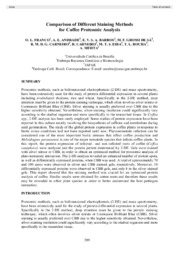Comparison of different staining methods for coffee proteomic analysis.
Comparison of different staining methods for coffee proteomic analysis.
Autoria: FRANCO, O. L.; ANDRADE, A. E.; BARROS, E. V. S. A.; SA, M. F. G. de; CARNEIRO, R. M. D. G.; CARNEIRO, R.; EIRA, M. T. S. da; ROCHA, T. L.; REIS, A. M. dos
Resumo: Proteomic methods, such as bidimensional electrophoresis (2-DE) and mass spectrometry, have been extensively used for the study of protein differential expression in several plants including Arabidopsis thaliana, rice and wheat. Specifically in the 2-DE method, deep attention must be given to the protein staining technique, which often involves silver nitrate or Coomassie Brilliant Blue (CBB). Silver staining is usually preferred over CBB due to the higher sensitivity obtained. Nevertheless, silver-staining resolution could significantly vary according to the studied organism and more specifically to the researched tissue. In Coffea spp., 2-DE analysis has been rarely employed. Some studies of protein expression have been reported in this culture mainly involving the biosynthesis of caffeine and metabolism during seed germination. The study of the global protein expression in coffee plants in response to biotic stress conditions had not been reported until now. Phytonematode infection can be considered one of the most important biotic stresses that affect coffee production and Meloidogyne paranaensis is one of the major nematode species that infects coffee plants. In this report, the protein expression of infected- and non-infected roots of coffee (Coffea canephora) were analyzed and the protein pattern determined by 2-DE. Gels were stained with silver nitrate or CBB, in order to obtain an optimized method for proteomic analysis of plant-nematode interaction. The 2-DE analysis revealed an enhanced number of protein spots, as well as differentially expressed proteins, when CBB was used. A total of approximately 70 and 100 spots were observed in silver and CBB stained gels, respectively. Moreover, 18 differentially expressed proteins were observed in CBB gels, and only 8 in the silver stained gels. This report showed that the staining method was crucial for an optimized protein analysis of coffee. Similar results were obtained for cotton roots and therefore these results may be extended to other plant species in order to better understand the host-pathogen interaction.
Ano de publicação: 2007
Tipo de publicação: Artigo em anais e proceedings
Unidade: Embrapa Café
Palavras-chave: Bidimensional electrophoresis, Proteomic method
Observações
1 - Por padrão são exibidas publicações dos últimos 20 anos. Para encontrar publicações mais antigas, configure o filtro ano de publicação, colocando o ano a partir do qual você deseja encontrar publicações. O filtro está na coluna da esquerda na busca acima.
2 - Para ler algumas publicações da Embrapa (apenas as que estão em formato ePub), é necessário ter, no celular ou computador, um desses softwares gratuitos. Sistemas Android: Google Play Livros; IOS: iBooks; Windows e Linux: software Calibre.
Acesse outras publicações
Acesse a Base de Dados da Pesquisa Agropecuária (BDPA) para consultar o acervo completo das bibliotecas da Embrapa.

